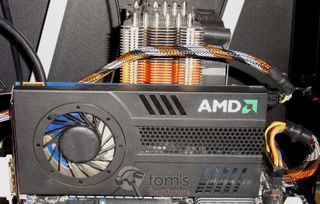Benchmarking AMD's 768-Shader Pitcairn: Not For Public Consumption
Last week we reported that an engineering sample card with 768 shaders accidentally found its way into our lab instead of the HD 7850 we were expecting. This GPU may be meant for engineers, but it piqued our interest, since it happens to fill a large gap.
Impressions: Overall Performance, Power, Thermals
Overall Performance
Cumulative frame rates are often used to tally up overall performance. The trouble is that this approach doesn’t always allow a completely objective conclusion, since there are too many factors to consider. With several new driver revisions being released over the course of a year and patches making tweaks to the 3D engines, games are in a constant state of flux.
But here’s what we can say. In titles like Mafia 2, GTA IV, StarCraft II, and Batman: Arkham City, our engineering sample demonstrates performance in line with other Radeon cards based on the GCN architecture in these games. Consequently, we're confident that the overall picture being painted isn't being tinged by this board prototype status. It's a legitimate Pitcairn chip with a quarter of its shaders disabled, but otherwise fully functional. In many other benchmarks, the engineering sample turns out to be a good counter to Nvidia’s GeForce GTX 560 Ti, beating that card in several cases. Meanwhile, the Radeon HD 6870 turns out to be noticeably slower (the two exceptions being Batman: Arkham City and, to a much lesser degree, StarCraft II).
To sum it up, the engineering sample always does well when the fully-fledged Radeon HD 7850 shows strong as well, with performance scaling almost perfectly with the number of shaders.

Power Consumption and Thermals
Once again, since we’re dealing with an engineering sample on a pre-production board, we don’t think it’s fair to make any statements about the card’s power consumption or its thermal output. If you flip back to page two, you can find the maximum power consumption that we measured, but consider it in the context of a experimental piece of hardware that was never intended to be used on this board. The good news is that the Pitcairn engineering sample peaks out around 10 W under the HD 7850. Unlike the Radeon HD 5830 that actually drew more power when idle than the full HD 5850 from which it was derived, the engineering sample Pitcairn has no such problems.
As far as the single-slot cooling solution goes, we’ll follow up on this once we have a final sample of the card we were originally going to test. For now, we’ll just say that a lower power consumption also means lower thermal output, which should have a positive effect on cooling and noise, depending on the specific cooler, of course.
Stay on the Cutting Edge
Join the experts who read Tom's Hardware for the inside track on enthusiast PC tech news — and have for over 25 years. We'll send breaking news and in-depth reviews of CPUs, GPUs, AI, maker hardware and more straight to your inbox.
Current page: Impressions: Overall Performance, Power, Thermals
Prev Page Benchmark Results: DiRT3, StarCraft 2, And Battlefield 3 Next Page A Wistful ConclusionMost Popular


